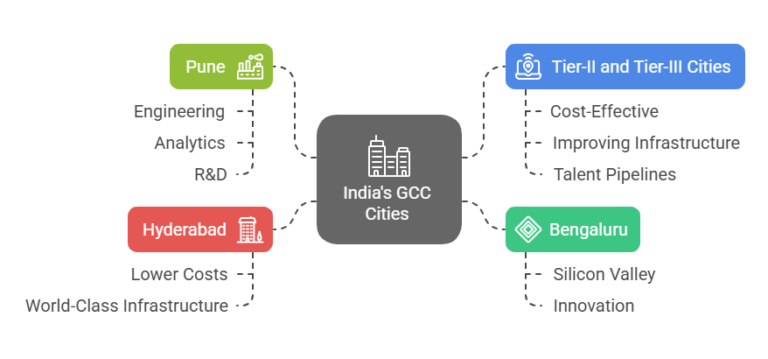GCC Setup In India
India has solidified its position as a global hub for multinational corporations (MNCs) seeking to establish Global Capability Centers (GCCs). These centers, often known as Global In-House Centers (GICs), have evolved from being cost-saving units to innovation-driven hubs that foster operational excellence. Currently hosting over 1,800 GCCs, India accounts for nearly 50% of the world’s GCC footprint. By 2030, the number of GCCs in India is expected to exceed 2,000, generating revenues of $99–$105 billion annually.
Here’s a comprehensive guide to turning your GCC setup in India into a reality, leveraging India’s unique advantages.
Why Choose India for Your GCC?
1. Cost Efficiency
India offers unparalleled cost advantages. Salaries for highly skilled professionals are 30–50% lower than in Western markets, while real estate costs are significantly more affordable, particularly in Tier-II and Tier-III cities like Kochi and Coimbatore. Survey insights reveal that companies establishing GCCs in India report up to a 70% reduction in IT talent acquisition costs and a 40% reduction in infrastructure expenses.
2. Access to Skilled Talent
India’s workforce is one of the largest and most qualified globally. Producing over 2.3 million STEM graduates annually, the country ensures a continuous supply of talent specializing in emerging fields like artificial intelligence (AI), machine learning (ML), and data science. This makes setting up a GCC in India an attractive prospect for companies prioritizing innovation and operational efficiency.
3. Government Incentives
Supportive policies amplify India’s appeal as a GCC destination. Relaxed foreign direct investment (FDI) norms, tax benefits in Special Economic Zones (SEZs), and state-specific GCC initiatives contribute to the growth of India’s GCC ecosystem. For example, Karnataka’s GCC policy (2024–2029) aims to establish 500 new GCCs by 2030, providing subsidies for capital expenditure, talent development, and operational costs.
4. Thriving Ecosystem
India’s robust digital infrastructure, vibrant startup culture, and regulatory support contribute to a thriving ecosystem. Cities like Bengaluru, Hyderabad, and Pune are established GCC hubs, while Tier-II and Tier-III cities are emerging as cost-effective alternatives with growing infrastructure and talent availability.
What are the Key GCC Hubs in India?
India is home to several major cities that are popular destinations for Global Capability Centers, each with its unique advantages:
- Bengaluru: Often called the tech capital of India, ideal for innovation and technology-focused GCCs.
- Hyderabad: Known for its modern infrastructure and a blend of IT and pharmaceutical sectors.
- Pune: A hotspot for skilled talent in engineering and manufacturing.
- Chennai: Favored for automotive, manufacturing, IT, and financial services.
- Mumbai: India’s financial capital, ideal for banking, finance, and media GCCs.
- Gurugram and Noida: Modern infrastructure and proximity to the capital attract IT and consulting GCCs.
Steps to Set Up a GCC in India
1. Define Strategic Goals
Align your GCC objectives with your company’s broader vision—be it cost optimization, innovation, or customer experience.
2. Conduct a Feasibility Study
Evaluate potential markets, regulatory landscapes, and cost structures. For example, Bengaluru offers top-tier talent at a premium, while cities like Ahmedabad provide cost-effective alternatives.
3. Choose the Right Location
Each city has strategic advantages:

- Bengaluru: Tech and innovation.
- Hyderabad: Cost-effective with world-class infrastructure.
- Pune: Engineering, analytics, and R&D.
- Tier-II/III Cities: Affordable with growing talent pipelines.
4. Legal and Regulatory Compliance
Comply with Indian corporate laws—prepare MoU, Articles of Association, obtain DINs, etc. Much of the process is digital and efficient.
5. Build a Skilled Team
Partner with universities and training institutions. Companies like Microsoft and IBM collaborate with institutions to develop AI, ML, and cybersecurity skills.
6. Operational Frameworks and SOPs
Set clear SOPs for roles, responsibilities, and performance metrics to ensure accountability and efficiency.
7. Leverage Technology
Adopt AI, generative AI, ML, and cloud computing. Use RPA to automate and streamline operations.
Key Cost Components of Setting Up a GCC in India
- Infrastructure: Office space, utilities, IT infrastructure.
- Human Resources: Recruitment, salaries, training.
- Legal Compliance: Business registration and regulatory adherence.
- Technology: Hardware, software, digital tools.
- Operations: Maintenance, security, and admin costs.
GCC Models: Choosing the Right Fit
1. DIY Model
Complete in-house setup and control. Best for companies with strong internal capabilities.
2. Build-Operate-Transfer (BOT)
Third-party sets up and manages the GCC, later transferring ownership. Ideal for new entrants.
3. Hybrid Models
Combines DIY and BOT through joint ventures or virtual captives, balancing control and flexibility.
Challenges and Solutions
- High Attrition: Mitigate with inclusive culture, benefits, and growth paths.
- Regulatory Complexity: Use local experts for compliance.
- Infrastructure Gaps in Tier-II/III Cities: Opt for SEZs or global business parks.
Case Study: Microsoft’s India GCC
Microsoft’s Hyderabad GCC started with IT support and evolved into a hub for AI and cloud innovation. With 8,000+ employees, it exemplifies operational efficiency, cost savings, and innovation.
The Future of GCCs in India
- Digital Transformation: 30% of GCCs to become innovation hubs by 2030.
- Diverse Talent: Focus on inclusive, innovative workforces.
- Supportive Policy: Data localization and cybersecurity laws to enhance stability.
Conclusion
Establishing a GCC in India is a strategic opportunity to unlock innovation, efficiency, and long-term value. With India’s cost advantages, deep talent pool, and supportive ecosystem, your GCC can become a powerful engine for global growth. Proper planning and a forward-looking vision will ensure that your Indian GCC is not just an extension but a transformation of your business.
